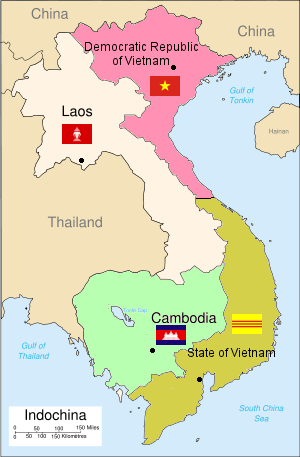
The Geneva Conference was intended to settle outstanding issues resulting from the Korean War and the First Indochina War and involved several nations. It took place in Geneva, Switzerland, from 26 April to 20 July 1954.[1][2] The part of the conference on the Korean question ended without adopting any declarations or proposals and so is generally considered less relevant. On the other hand, the Geneva Accords that dealt with the dismantling of French Indochina proved to have long-lasting repercussions. The crumbling of the French colonial empire in Southeast Asia led to the formation of the states of the Democratic Republic of Vietnam (North Vietnam), the State of Vietnam (precursor of the future Republic of Vietnam, or South Vietnam), the Kingdom of Cambodia, and the Kingdom of Laos. Three agreements about French Indochina, covering Cambodia, Laos, and Vietnam, were signed on 21 July 1954 and took effect two days later.
Diplomats from South Korea, North Korea, the People's Republic of China, the Soviet Union, and the United States dealt with the Korean side of the conference. For the Indochina side, the Accords were between France, the Viet Minh, the Soviet Union, the People's Republic of China, the United States, the United Kingdom, and the future states being made from French Indochina.[3] The agreement temporarily separated Vietnam into two zones: a northern zone to be governed by the Viet Minh and a southern zone to be governed by the State of Vietnam, which was headed by former Nguyễn dynasty emperor Bảo Đại. A Conference Final Declaration, which was issued by the British chairman of the conference, provided that a general election be held by July 1956 to create a unified Vietnamese state. Despite helping create some of the agreements, they were not directly signed or accepted by delegates of the State of Vietnam and the United States. After a military buildup in North Vietnam, the State of Vietnam, under Ngo Dinh Diem, subsequently withdrew from the proposed elections. Worsening relations between the North and South would eventually lead to the Vietnam War.
- ^ "Indochina – Midway in the Geneva Conference: Address by the Secretary of State". Avalon Project. Yale Law School. 7 May 1954. Retrieved 29 April 2010.
- ^ Young, Marilyn (1991). The Vietnam Wars: 1945–1990. New York: HarperPerennial. p. 41. ISBN 978-0-06-092107-1.
- ^ Archive, Wilson Center Digital. "Wilson Center Digital Archive". digitalarchive.wilsoncenter.org.